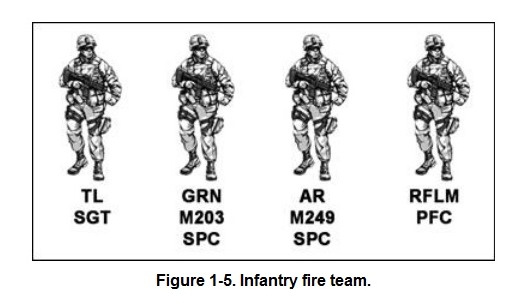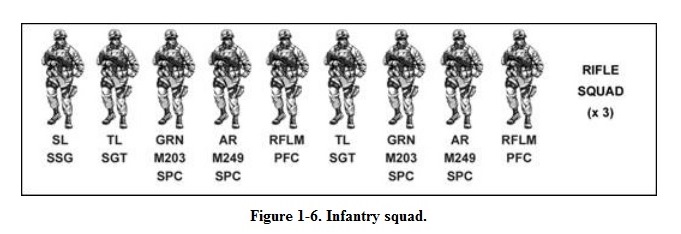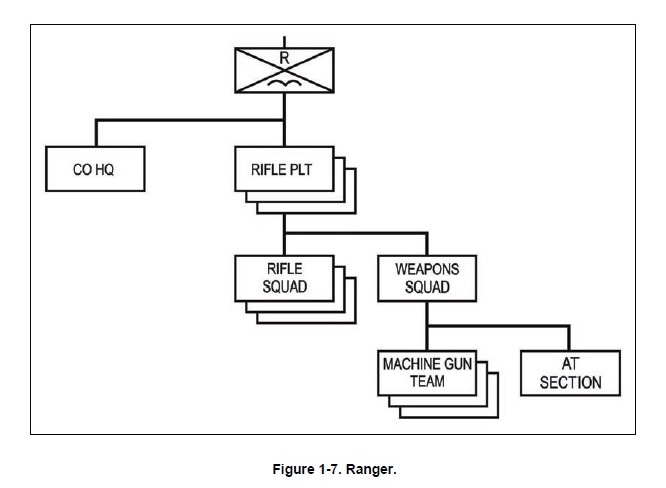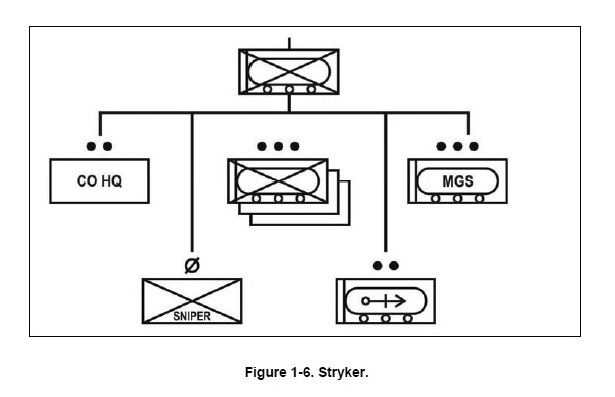INF Org. Posn & Roles (Indiv-Co)
Infantry Unit Organization, Roles, Positions & Responsibilities
This is a synopsis of the organization, personnel positions, roles & responsibilities of infantry organizations from the individual to the company commander. One of the first tasks to understanding an organization is knowing how it’s organized and what the different parts of that organization do. Without that basic information much of the nuances and even fundamental lessons one can obtain from reading, listening or studying the Infantry are liable to be lost. This serves as a refresher for older infantrymen and a basic fundamental reference for those interested in understanding small unit infantry actions. It applies to most US Army and Marine Infantry formations.
PERSONNEL, RESPONSIBILITIES & ORGANIZATION OF INFANTRY SQUADS & PLATOONS
Light & Stryker Infantry platoons consist of three Infantry squads, a weapons squad, and a platoon headquarters. Bradley Infantry Platoons do not have a weapons squad. They have four Bradleys to rely upon for additional firepower.
Platoon Headquarters
The platoon HQ has three permanently assigned members: the platoon leader (PL), the platoon sergeant (PSG), and the radiotelephone operator (RTO). There is no assigned RTO in Bradley mounted Infantry. Depending on task organization, the platoon HQ may receive augmentation. Two traditionally-attached assets are the fire support team, and the platoon medic.
Platoon Leader
PL is the leader of the platoon and responsible for all the platoon does or fails to do. He directs his squad leaders and leads by personal example. In the conduct of his duties he consults the PSG in all matters related to the platoon. He must know his Soldiers and how to employ the platoon and its organic and supporting weapons. Partial list of responsibilities include:
- · Leads the platoon in supporting the higher’s missions.
- · Assigns clear tasks and purposes to his squads. Maneuvers squads, fighting elements and synchronizes the efforts of squads.
- · Requests and controls supporting assets.
- · Ensures 360-degree, three-dimensional security is maintained and controls the emplacement of key weapon systems.
- · Places himself where he is most needed to accomplish the mission.
- · Be prepared to assume the duties of the company commander or company executive officer.
Platoon Sergeant
The PSG is the senior NCO in the platoon and second in command. He sets the example in everything. The PSG advises the PL in all administrative, logistical, and tactical matters. The PSG is responsible for the care of the men, weapons, and equipment of the platoon. As the platoon’s second in command, he has no formal assigned duties except those assigned by the PL. Some responsibilities PSGs traditionally execute—
- · Ensures the platoon is prepared to accomplish its mission, to include supervising precombat checks and inspections.
- · Acts where best needed to help C2 the engagement (typically in the base of fire element).
- · Receives squad leaders’ administrative/maintenance reports, requests for rations, water, fuel, and ammunition. Coordinates with higher headquarters for logistical support (usually the company’s first sergeant or executive officer). Manages the unit’s combat load prior to operations and monitors logistical status during operations.
- · Establishes and operates the unit’s casualty collection point (CCP) to include directing the platoon medic and aid/litter teams in moving casualties; maintains platoon strength levels information; consolidates and forwards the platoon’s casualty reports; receives and orients replacements.
Platoon Radiotelephone Operator
The platoon radiotelephone operator (RTO) is primarily responsible for the platoon’s communication with its controlling HQ (usually the company). During operations, the RTO —
- · Monitors communications at all times. Reports breaks in communication with higher immediately to the PL or PSG.
- · Be an expert in radio procedures and report formats such as call for indirect fire or MEDEVAC, and all types of field expedient antennas.
- · Assists the PL with information management.
Infantry Fire Team
The Infantry fire team is designed to fight as a team. The automatic rifleman (AR) provides an internal base of fire with the ability to deliver sustained suppressive small arms fire on area targets. The rifleman provides accurate lethal direct fire for point targets. The grenadier provides high explosive (HE) indirect fires for both point and area targets. A team leader (TL) who provides C2 through leadership by example (“Do as I do”) leads this team.
Rifleman
The rifleman in an infantry platoon is a position not simply a title. The rifleman is currently equipped with an M16/M4 rifle. Placing well-aimed, effective fire on the enemy is his primary capability. Additionally, the rifleman must—
- · Be an expert on his weapon system—his rifle, its optics, and its laser aiming device. He must be effective with his weapon system day or night. He must be capable of engaging all targets with well-aimed shots.
- · Be able to employ all weapons of the squad, as well as common munitions.
- · Be able to construct and occupy a hasty firing position and know how to fire from it. He must know how to quickly occupy covered and concealed positions in all environments and what protection they will provide for him from direct fire weapons. He must be competent in the performance of these tasks while using night vision devices.
- · Be able to fight as part of his unit, which includes being proficient in his individual tasks and drills, being able to fight alongside any member of the unit, and knowing the duties of his teammates and be prepared to fill in with their weapons if needed. This is the difference between being a “rifleman” and being a rifleman in an infantry squad.
- · Be able to contribute as a member of special teams to include wire/mine breach teams, EPW search, aid/litter, and demolitions.
- · Be able to manage his food, water, ammunition during operations and administer buddy aid as required.
- · Be prepared to assume the duties of the automatic rifleman and team leader.
Grenadier
The grenadier is currently equipped with an M203 weapon system consisting of an M16/M4 rifle and attached 40-mm grenade launcher. The grenadier provides the fire team with a high trajectory, high explosive capability out to 350 meters. The grenadier with M203 performs three functions: suppress and destroy enemy Infantry and lightly-armored vehicles with HE or high explosive dual purpose; provide smoke to screen and cover his squad’s fire and movement; and employ illumination rounds to increase his squad’s visibility and mark enemy positions. The grenadier must—
- · Be able to accomplish all rifleman tasks.
- · Be an expert on his weapon system able to engage targets with appropriate round types day and night. Identify 40-mm rounds by shape/color. Know how to employ each type of round and its minimum safety constraints. Make adjustments from the first round fired so he can attain a second-round hit. Load the grenade launcher quickly in all firing positions and while running.
- · Be prepared to assume the duties of the automatic weapons gunner and the TL.
Automatic Rifleman
The AR’s primary weapon is currently the 5.56-mm M249 machine gun. The M249 provides the unit with a high volume of sustained suppressive and lethal fires for area targets. The AR employs the M249 machine gun to suppress enemy Infantry and bunkers, destroy enemy automatic rifle and antitank teams, and enable the movement of other teams and squads. He is normally the senior Soldier of the fire team. The AR must—
- · Be able to accomplish all of the tasks of the rifleman and the grenadier.
- · Be an expert in the operation and employment of the M249 day & night. Be able to engage targets from the prone, kneeling, and standing positions with and without night observation devices. Provide suppressive fire on targets so his teammates can close with and destroy the enemy.
- · Be prepared to assume the duties of the TL and SL.
Team Leader
The TL leads by personal example. He has authority over his subordinates and overall responsibility for their actions. Under the fluid conditions of close combat, the TL must accomplish assigned missions using initiative without needing constant guidance from above.
The TL’s is a fighting leader who leads his team by example. He is responsible for the care of his team’s men, weapons, and equipment. During operations, the TL—
- · Is the SME on all of the team’s weapons and duty positions and all squad battle drills.
- · Leads his team in fire and movement. Controls the movement of his team and its rate and distribution of fire.
- · Assists the SL as required.
- · Determines his team’s combat load and manages its available classes of supply as required.
- · Is prepared to assume the duties of the SL and PSG.
Infantry Squad
There are several variations of Infantry, but currently only one type of Infantry squad. Its primary role is a maneuver or base-of-fire element. While the platoon’s task organization may change, the organization of the Infantry squad generally remains standard.
The Infantry squad is a model for all tactical task organizations. It is comprised of two fire teams* and a squad leader. It is capable of establishing a base of fire, providing security for another element, or conducting fire and movement with one team providing a base of fire, while the other team moves to the next position of advantage or onto an objective. The squad leader has two subordinate leaders to lead the two teams, freeing him to control the entire squad.
*Marine Infantry squads consist of three fire teams.
Squad Leader
The squad leader (SL) is the leader of the squad and responsible for all the squad does or fails to do. He directs his team leaders and leads by personal example. Centralized authority enables the SL to act decisively while maintaining troop discipline and unity. Under the fluid conditions of close combat, even in the course of carefully-planned actions, the SL must accomplish assigned missions on his own initiative without constant guidance from above.
The SL is responsible for the care of his squad’s men, weapons, and equipment. He leads his squad through two team leaders. During operations, the SL—
- · Is the SME on all battle drills, individual drills, the squad’s organic weapons, their employment and the employment of supporting assets. Knows weapon effects, surface danger zone(s) (SDZ), and risk estimate distance(s) (RED) for all munitions.
- · Controls the movement of his squad and its rate and distribution of fire (including call for and adjust fire). Effectively uses control measures for direct fire, indirect fire, and tactical movement.
- · Fights the close fight by fire and movement with two fire teams and available supporting weapons.
- · Selects the fire team’s general location and sector in the defense.
- · Communicates timely and accurate size, activity, location, unit, time, and equipment (SALUTE), spot reports (SPOTREPs) and status reports, including;
- · Status to the platoon leader (including squad location and progress, enemy situation, enemy killed in action [KIA], and security posture).
- · Status of ammunition, casualties, and equipment to the platoon sergeant.
- · Conducts troop-leading procedures (TLP).
- · Assumes duties as the platoon sergeant or platoon leader as required.
Squad Designated Marksman
A rifleman may be assigned as the squad designated marksman (SDM). SDMs are not squad snipers. They are fully integrated members of the rifle squad who provide an improved capability for the rifle squad. They do not operate as semi-autonomous elements on the battlefield as snipers, nor do they routinely engage targets at extreme ranges common to snipers. The SDM employs an optically-enhanced general-purpose weapon. He also receives training within the unit’s resources to improve the squad’s precision engagement capabilities at short and medium ranges. In contrast, snipers use specialized rifles and match ammunition, and are specially selected and trained to provide precision fire at medium and long ranges (normally from stationary positions).
The SDM is chosen for demonstrated shooting ability, maturity, reliability, good judgment, and experience. The SDM must be able to execute the entire range of individual and collective rifleman tasks within the squad (see FM 3-22.9, Rifle Marksmanship M16A1, M16A2/3, M16A4, and M4 Carbine.)
The SDM engages visible point targets with target priorities of enemy leaders, personnel with radios, automatic weapons crews, enemy soldiers with rocket launchers or sniper rifles, or others as directed by his squad and platoon leaders. He is particularly effective against targets that are only partially exposed or exposed for only brief periods of time. An SDM delivers effective fire against very small targets such as loopholes or firing slits, bunker apertures, partially obscured and prone enemy snipers, crew-served weapons teams at close to medium ranges, and rapidly moving targets. He must be able to detect and engage targets rapidly from awkward or nonstandard firing positions while he, the target, or both are moving.
Employment in Combat
The designated marksman moves and fights in combat as an integral part of the Infantry squad. He provides precision support fire in the offense during the assault and engages targets to the maximum effective range of his weapon in offensive, defensive, and retrograde operations. His ability to deliver lethal, precise, and discriminating fire during stability operations forms the basis of counterinsurgency combat. He enhances the squad’s effectiveness and its ability to maneuver and accomplish its mission. When employed tactically, designated marksmen provide precision direct fire as directed by the squad leader. This fire limits fratricide, collateral damage, and noncombatant casualties.
Types of operations in which designated marksmen are most useful include:
- · Situations in which the squad requires precision fires in an urban area containing an enemy mixed with multiple noncombatants or in those where the applicable ROE restricts the use of area-fire weapons. Civil disturbances involving armed rioters mixed with noncombatants.
- · Close range engagements that have an immediate, critical need for precision rifle fire.
- · Situations in which the unit is facing an enemy with trained marksmen or armed irregulars being used as snipers that must be countered.
- · Vehicle and personnel checkpoint operations in which the squad needs an element in armed overwatch.
- · Attacking specific targets identified by the platoon or squad leader.
- · Covering the approach and entry of the assault element to the objective. Eliminating unexpected threats in and around the objective that appear and disappear suddenly and without warning.
- · Situations that require precision fire on apertures, exposed personnel, muzzle flashes, or other designated point targets.
- · Situations with friendly troops on or near the objective when mortars, machine guns, and grenade launchers must cease or shift their fires to prevent fratricide. The designated marksman may be able to continue to fire in support of the assault.
Infantry Weapons Squad
The Infantry weapons squad provides the primary base of fire for the platoon’s maneuver. It is comprised of two medium machine gun teams, two medium close combat missile (CCM) teams, and a weapons squad leader (Figure 1-7).
Medium Machine Gun Team
The two-man medium machine gun team is comprised of a gunner and an assistant gunner (AG). The weapons squad has two machine gun teams. These teams provide the platoon with medium-range area suppression at ranges up to 1,000 meters during day, night, and adverse weather conditions.
Gunner
The gunner is normally the senior member of the team. During operations, the gunner—
- · Is responsible for his assistant gunner, all the gun equipment and for putting the gun in and out of action.
- · Is the SME for the information contained in FM 3-22.68, Crew-Served Machine Guns, 5-56-mm and 7.62-mm.
- · Assists the weapons squad leader and is prepared to assume his responsibilities.
Assistant Gunner
The assistant gunner is the second member of the gun team. He is prepared to assume the gunner’s role in any situation. During operations, the assistant gunner will—
- · Watch for Soldiers to the flanks of the target area or between the gun and the target. Spot rounds and report recommended corrections to the gunner.
- · Provide a supply of ammunition to the gun when employed and obtains ammunition from other Soldiers who are carrying machine gun ammunition.
- · Report round counts of ammunition in accordance with the unit standard operating procedure.
- · Immediately assume the role of gunner if the gunner is unable to continue his duties.
Close Combat Missile Team
The two-man close combat missile team is comprised of a gunner and an ammunition handler. Currently, the team uses the Javelin missile system. The weapons squad has two close combat missile teams. This system provides the platoon with an extremely lethal fire-and-forget, man-portable, direct- and top-attack capability to defeat enemy armored vehicles and destroy fortified positions at ranges up to 2,000 meters. The Javelin has proven effective during day, night, and adverse weather conditions.
Weapons Squad Leader
The weapons squad leader leads his teams by personal example. He has complete authority over his subordinates and overall responsibility for those subordinates’ actions. The weapons SL is normally the senior SL, second only to the PSG. He performs all of the duties of the rifle SL. In addition, the weapons SL—
- · Recommends machine gun employment to the PL.
- · Coordinates directly with the PL for machine gun base-of-fire effects and plans accordingly.
- · Monitors ammunition expenditure.
- · Coordinates directly with the PL in placement of the Javelin close Combat Missile System (CCMS) to best cover armored avenues of approach in the defense and overwatch positions in the attack.
- · Performs the role of the PSG as required.
(Ref FM 3-21.8 The Infantry Rifle Squad & Platoon)
TYPES, CHARACTERISTICS & ORGANIZATION OF INFANTRY RIFLE COMPANIES
Infantry, Heavy, Stryker, and Ranger comprise the four types of Infantry rifle companies. Some of these have specialized capabilities such as airborne and air assault. Though differences exist between them, they share some similarities in organization, tactics, and employment. The main differences lie in the means of transportation to and on the battlefield, and in the organic supporting assets available to them.
Ranger
Ranger units are rapidly deployable, airborne-capable, and trained to conduct joint strike operations with (or in support of) special operations units of all services in any environment. They plan and conduct special military operations to support national policies and objectives. They also conduct direct-action missions to support the geographic combatant commanders and operate as conventional Infantry units when integrated with other combined arms elements. (FM 7-85 is the capstone manual for Ranger operations.)
Heavy
Heavy Infantry units are mounted on Bradley fighting vehicles. These units are task organized with M1 Abrams tanks in combined arms battalions of the Heavy brigade combat team (HBCT). These heavy units are highly mobile with tremendous combined arms firepower. They are best suited to less restrictive terrain and combat against an armored enemy.
Stryker
The battalion is organized three-by-three: three rifle companies, with three rifle platoons each. Companies fight as combined arms teams with a section of organic 60-mm and strap-on 81-mm mortars, mobile gun system (MGS) platoon, and sniper team. The SBCT units are equipped with the Stryker Infantry carrier vehicle (ICV). The SBCT battalion retains most of the capabilities of the other Infantry plus the additional mobility of Stryker vehicles. Stryker companies operate across the full spectrum of modern combat operations. They are organized to maintain tactical flexibility within restricted and severely
Company Commander
The company commander leads by personal example and is responsible for everything the company does or fails to do. His principle duties include the key areas of tactical employment, training, administration, personnel management, maintenance, force protection, and sustainment of his company.
Given the asymmetrical, noncontiguous environment, he must now integrate and synchronize a greater mix of forces for full spectrum operations including other combined arms and combat support elements, civil affairs (CA), psychological operations (PSYOP), interpreters, media, unmanned aerial system (UAS) and robotics teams. Among other things, he–
- · Commands and controls through his subordinate leaders.
- · Employs his company to accomplish its mission according to the battalion commander’s intent and concept.
- · Selects the best location to maneuver the platoons and other elements.
- · Conducts mission analysis and troop-leading procedures (TLP) and issues operation orders for company tactical operations.
- · Maintains and expresses situation awareness and understanding.
- · Resources the platoons and other elements and requests battalion support when needed.
- · Ensures that the company command post (CP) effectively battletracks the situation and status.
- · Provides a timely and accurate tactical picture to the battalion commander and subordinate units.
- · Implements effective measures for force protection, security, and accountability of forces and systems.
- · Develops the leadership and tactical skill of his platoon leaders.
Executive Officer
The XO is second in command. His primary role is to assist the commander in mission planning and accomplishment. He assumes command of the company as required and ensures that tactical reports from the platoons are forwarded to the battalion tactical operations center (TOC). The XO locates where he can maintain communications with the company commander and the battalion.
- · He plans and supervises, before the battle along with the 1SG, the company’s sustainment operations; ensures that precombat inspections are complete. The XO plans and coordinates logistical support with agencies outside the company while the 1SG does the same internally. He prepares or aids in preparing paragraph 4 of the company operation order (OPORD). He may also help the company commander plan the mission.
- · He coordinates with higher, adjacent, and supporting units. He may aid in control of critical events of the battle such as a passage of lines, bridging a gap, or breaching an obstacle; or, he may assume control of a platoon attached to the company during movement.
- · He performs as LZ/PZ Control Officer which may include straggler control, casualty evacuation, resupply operations, or air-ground liaison.
- · He leads Quartering Party or Detachment, an element consisting of representatives of various company elements. Their purpose is to precede the company and reconnoiter, secure, and mark an assembly area.
The XO might lead a detachment with other tactical tasks including shaping or sustaining force leader in a company raid or attack, control company machine guns, or mortar section. He may also–
- · Lead the reserve.
- · Lead the detachment left in contact during a withdrawal.
- · Control attachments to the company.
- · Serve as movement control officer.
First Sergeant
The 1SG is the senior noncommissioned officer (NCO) and normally the most experienced Soldier in the company. He is the commander’s primary tactical advisor and the expert on individual and NCO skills. He helps the commander plan, coordinate, and supervise all activities that support the unit mission. He operates where the commander directs or where he can best influence a critical point or what is viewed as the unit’s decisive point. The first sergeant–
- · Supervises routine operations. This can include enforcing the tactical standing operating procedures (TSOP); planning and coordinating both training and full spectrum operations; and administering replacement operations, logistics, maintenance, communications, field hygiene, and casualty evacuation operations.
- · Supervises, inspects, and influences matters designated by the commander as well as areas that depend on his expertise such as Soldier care, force protection, security, and accountability.
- · Assists the XO and keeps himself prepared to assume the XO’s duties, if needed.
- · Leads task-organized elements or subunits for the company’s shaping effort or other designated missions.
(Ref FM 3-21.10 The Infantry Rifle Company)
Please submit comments, questions or suggestions on the announcing thread here or go to the commo check and send me an e-mail.







